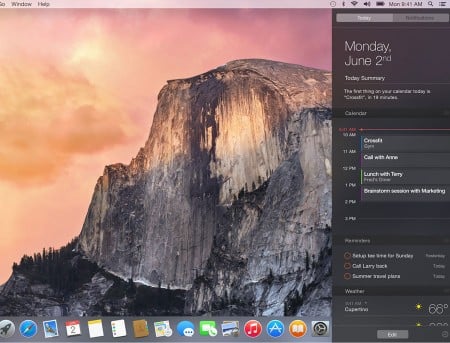It’s early June, and you know what that means: it’s time for Apple to talk about what it has coming for Mac OS X, the operating system running on its laptops and desktop computers, and this time, instead of hitting the waves in Mavericks, Apple is scaling the big mountain El Capitan for its Yosemite release.
For those who have never heard of it, Yosemite is one of America’s largest national parks, wedged between California and Nevada and providing some of the most picturesque landscape you can see just a few hours away from San Francisco, Sacramento, or one of the places this writer grew up in, Modesto (George Lucas was from there, but don’t worry, you’re not missing much).
It’s also the place that Ansel Adams — one of the most celebrated black and white photographers ever — spent so much time documenting, so the landscape has also had an impact on the arts scene.
But it’s about to make an impact on the world of technology, as Apple names its next Mac OS release after this part of the world.
Announced this week and set to be available as a free update, Mac OS X 10.10, as Apple is calling it, will update the look of Apple’s operating system, help you find more files, streamline the design of Apple’s Safari web browser, and even let you make phone calls from your Mac.
Some of these updates include more of what current features do, such as the “Today” view in the Notification Centre, which shows you more of your world, such as weather, stock information, and what’s going on in social networks, with extra content coming from widgets that you’ll be able to find on Apple’s Mac App store.
A new part of Mac’s folder explorer Finder is being added called “iCloud Drive” which will store files and folders on your Apple-connected cloud drive, also known as the iCloud. Photos and documents will be able to access it easily, with the iPhone and iPad connected through this system, and even any Windows PCs you might be reliant on or using.
Safari has been updated for better web browsing with more HTML5 video support and even some improvements to Javascript, with Apple saying it’s now faster than Google Chrome (we wonder for how long for), while Apple’s Mail will send big attachments more easily thanks to the new “Mail Drop” feature.
The design has also changed, with a different font for better readability and a translucent design, that looks both flat and modern, and yet still retains some of the Apple design charm from the past.
Even Apple’s global search system Spotlight will take centre stage, because when you press the search button, you won’t get just the little search bar in the top right, but a more central interface showing you more of what you’re looking for across not just your files, but the world around you. It’s a similar approach to what Google has been doing with its Google Now interface on Android, and will search venues around you, stores, and even do mathematical conversions for you.
One of the most important changes, however, comes from how Apple’s Mac OS is going to be dealing with Apple’s other operating system, that of iOS, which runs on its iPhone.
In 10.10 “Yosemite,” your computer will be able to link up with an iPhone and answer phone calls from the laptop or desktop, so when the phone rings in another room, you can pick it up from your laptop.
It’s the same with SMS, with the messages being passed to iMessage, similar to how Android now links up with Google’s Hangouts app and shares the messages across systems.
We are confused over one thing with regards to OS X 10.10, and that’s the naming convention. We get the “Yosemite,” and we like that aspect, but if we’re really at OS X 10.10, wouldn’t that make previous numbers OS X 10.09, 10.08, and 10.07, and so on?
We’re checking with Apple to see how the company views decimal numbers, and in the meantime, we’ll get off our mathematical soapbox and go eat some lunch, realising that it’s probably easier for Apple to call this OS X 10.10 rather than OS X 11, which would imply a complete reinvention of the operating system, which isn’t what this is.
Rather, this version of Mac OS feels closer to a minor dot release, with updates and design shifts aimed at increasing productivity and bringing together more of what people expect a computer to do, instead of remaking the wheel, which a new operating system number would imply.
Those of you keen to test it out will be able to do so ahead of everyone from today if you have access to the Mac Developer Program, and Apple is even launching a beta program called the OS X Beta Program, which will provide the latest release of OS X (10.10) for people keen to see what the fuss is ahead of everyone else, though it’s limited to the first million people who sign up.
Outside of developers, expect a release date of “Spring” in Australia, with a price of free. Yosemite National Park’s Twitter account was quick to point out that you can enjoy it now — the real Yosemite, that is — and that it looks even better in real life (though Australians will need a plane ticket to get over and see it for themselves).
We invite you to check out Yosemite’s natural operating system. We’re good on a computer, but unmatched in person! pic.twitter.com/ZjTJO74tdQ
— Yosemite National Pk (@YosemiteNPS) June 2, 2014












